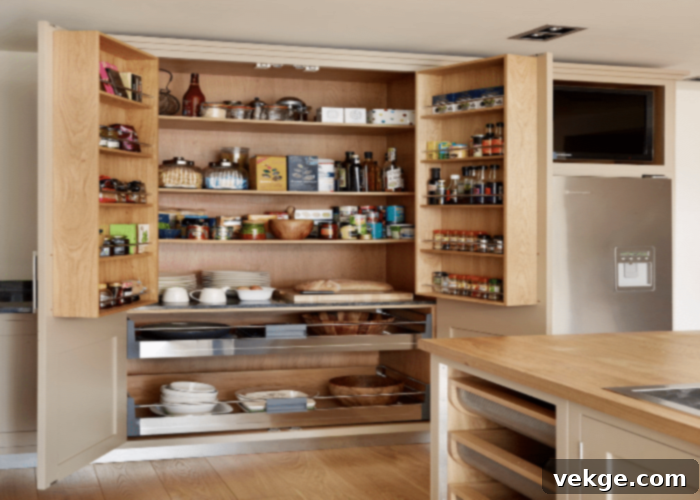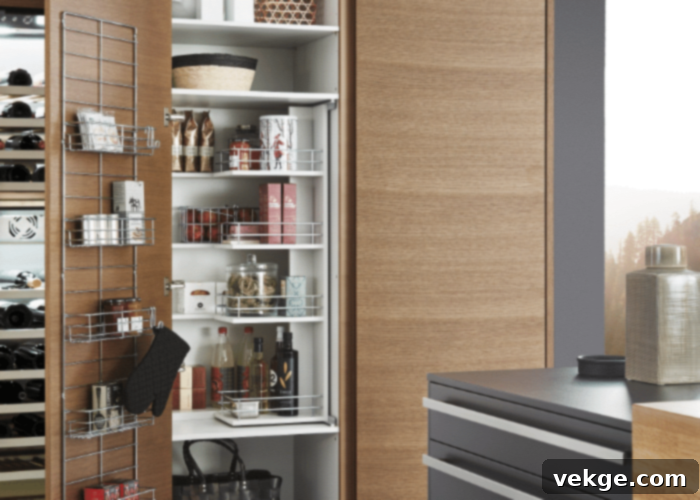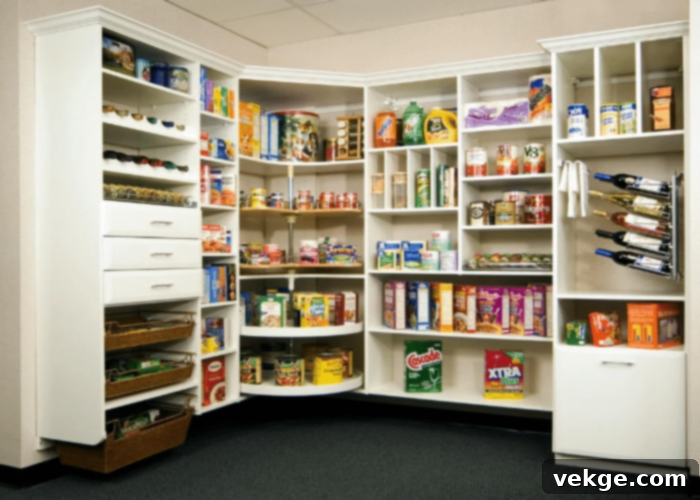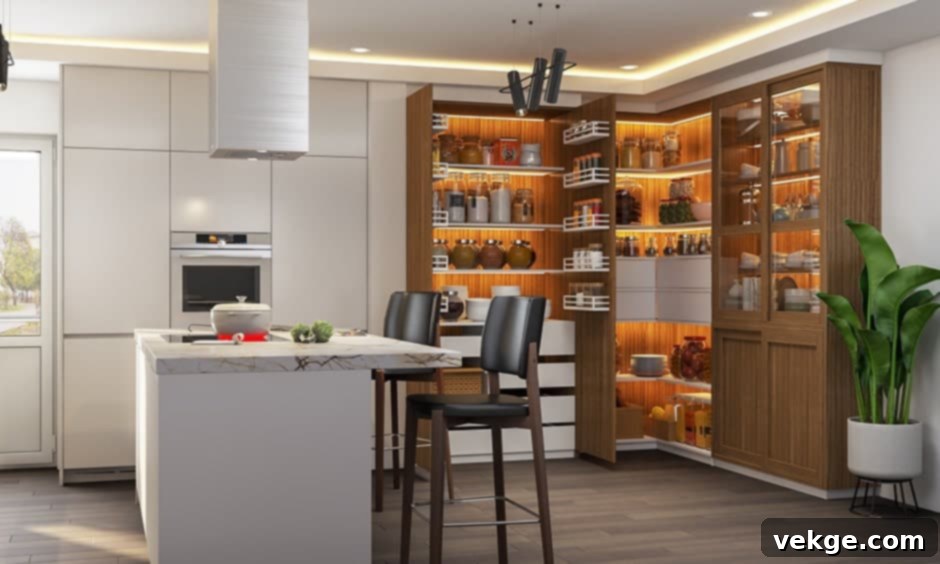Designing Your Dream Kitchen Pantry: A Guide to High-End Materials & Stylish Solutions
Creating a truly beautiful and functional interior space for your home demands meticulous attention to every detail, and your kitchen is certainly no exception. Often considered the heart of the home, the kitchen, and specifically its pantry, plays a crucial role in both daily living and overall home aesthetics. Constructing your kitchen pantry with the same level of precision and thoughtful design as the rest of your house ensures a cohesive, organized, and truly luxurious living environment.
At the core of any exceptional kitchen outline lies the careful selection of materials for your pantry. These foundational elements are paramount, dictating not only the durability and longevity but also the visual appeal of your fancy pantry. To achieve a well-organized, highly durable, and aesthetically pleasing modular kitchen, it is essential to devote special consideration to the materials chosen for your pantry cabinets and shelving. The right materials combine strength, style, and practicality, setting the stage for a truly magnificent culinary space.
Key Materials for High-End Pantry Designs
When envisioning a sophisticated and functional pantry, the choice of materials is fundamental. Each option offers unique advantages in terms of aesthetics, durability, maintenance, and cost. Understanding these distinctions is crucial to making an informed decision that aligns with your design aspirations and lifestyle needs.
1. Solid Wood: Timeless Charm and Natural Elegance
For those who value classic beauty and unparalleled warmth, nothing truly surpasses solid wood. Integrating solid wood into your kitchen pantry construction represents one of the finest investments you can make for the entire ambiance of your kitchen space. Whether your home embodies a traditional, rustic, or even a sleek modern aesthetic, wood possesses a remarkable versatility that complements virtually any design theme. Wooden pantries exude an exquisite, refined, and purposeful look, instantly elevating the perceived value and comfort of your kitchen.
The natural world of wood offers an incredible array of textures, colors, and grain patterns, from the rich hues of cherry and walnut to the lighter tones of maple and oak. Beyond its aesthetic appeal, wood is a naturally renewable resource, making it an environmentally conscious choice. While solid wood pantries may require a certain level of maintenance to preserve their beauty over time – such as regular cleaning, occasional polishing, and protection from excessive moisture – the investment is undoubtedly worthwhile. Its timeless quality and enduring elegance ensure that you can never go wrong when choosing wood for your pantry, promising decades of enjoyment and a perpetually stylish kitchen.

2. Plywood: Versatility and Strength in Engineered Wood
It’s crucial to understand the distinction between solid wood and plywood, though plywood often masterfully mimics the appearance of its solid counterpart. Plywood is an engineered wood product made by pasting multiple thin sheets or “plies” of wood veneer together with adhesives, usually on a composite substrate, with the grain of adjacent layers oriented at right angles. This cross-graining technique enhances its strength and dimensional stability, making it less prone to warping, shrinking, or swelling compared to solid wood, especially in fluctuating humidity levels.
With plywood, you gain the distinct advantage of extensive customization regarding color, texture, and finish to perfectly match your desired kitchen pantry style. This is because plywood surfaces can be polished, stained, painted, or veneered in a vast array of preferred colors and textures. It presents a highly affordable option without compromising significantly on durability. Plywood is also available in various gloss finishes, ranging from ultra-modern matte to classic semi-gloss, and sophisticated high gloss, allowing for diverse aesthetic expressions. Its ability to offer a sleek and minimal feel, combined with its low-maintenance nature, makes it a highly practical choice that doesn’t sacrifice visual appeal for your pantry.

3. Laminate: Durable, Diverse, and Design-Forward
In contemporary kitchen pantry designs, laminate has emerged as an incredibly popular material, prized for its remarkable durability and extensive design possibilities. Laminate is ingeniously constructed by pressing layers of Kraft paper together, topped with a decorative printed layer (offering patterns from realistic wood grains and stone textures to vibrant solid colors), and then protected by a hard, transparent plastic film or resin. This multi-layered composition is bonded under high pressure and heat, resulting in a robust and resilient surface.
The appeal of laminate lies in its incredible versatility. It is available in an astonishing number of patterns, designs, and textures, allowing you to perfectly capture a modern, rustic, industrial, or even a minimalist aesthetic for your kitchen pantry. Investing in laminate for your pantry offers numerous advantages: it is exceptionally low maintenance, highly resistant to scratches, scuffs, and impacts, and impressively durable against heat and moisture – crucial qualities for a busy kitchen environment. The sheer breadth of choices in designs, colors, and textures ensures that you can effortlessly find the ideal laminate to complement your kitchen’s overall theme and elevate its visual appeal, making it a smart and stylish selection for any high-end pantry project.

4. PVC (Polyvinyl Chloride): Budget-Friendly Durability and Water Resistance
For those seeking an aesthetic and durable material that is also remarkably budget-friendly, polyvinyl chloride (PVC) sheets present an excellent solution. These composite sheets, made entirely of plastic, are available in a diverse spectrum of colors, making them adaptable to various kitchen styles. One of PVC’s most significant advantages is its exceptional ease of maintenance; spills and splashes wipe clean effortlessly, and it is inherently resistant to pests and corrosion, a key benefit in a kitchen environment.
PVC sheets are often installed without the need for an additional substrate, simplifying the installation process. They are primarily available in two main types: hollow boards and foam boards. Hollow boards are lightweight and economical, ideal for lighter applications, while foam boards offer greater density and strength, suitable for more robust cabinet constructions. The surface of PVC sheets is naturally oil-proof and waterproof, making them an outstanding choice for kitchen pantries where exposure to moisture and spills is common. This resilience, combined with their cost-effectiveness and versatility, positions PVC as a highly practical and increasingly popular material for modern pantry designs, especially in humid climates or for homeowners prioritizing low maintenance.

Beyond Materials: The Finishing Touches for a High-End Pantry
While the core material selection forms the backbone of your kitchen pantry, the choice of finish is equally critical in defining its final look, feel, and long-term performance. A well-chosen finish enhances both the aesthetics and the functional attributes, such as durability and ease of cleaning. Common high-quality finishes include acrylic, laminate (as a surface finish), ultraviolet (UV) coated, and glass. Each offers distinct advantages:
- Acrylic Finishes: Known for their high-gloss, mirror-like sheen, acrylic finishes create a luxurious and expansive feel. They are highly durable and resistant to scratches and moisture.
- Laminate Finishes: As discussed, laminates offer incredible versatility in patterns and textures, providing a robust, easy-to-clean, and cost-effective surface.
- UV Finishes: These involve a coating that is cured under UV light, resulting in an exceptionally hard, scratch-resistant, and glossy surface that maintains its color over time.
- Glass Finishes: Glass inserts in pantry doors, or even entire glass shelves, add a sophisticated, modern, and light-filled element, perfect for displaying curated items.
Selecting the right finish is paramount; it directly impacts the longevity and functionality of your pantry. Many pantries require consistent maintenance and care over the years. Therefore, combining the right base material with an appropriate, high-quality finish ensures that your fancy pantry space will remain stunning and functional for decades to come. Furthermore, consider the overall color scheme. If you’re opting to paint elements of your pantry, choose hues that beautifully contrast or harmoniously blend with your kitchen’s existing decor. Strategic paint choices can instantly make your pantries appear more modern, brighter, and impeccably clean, transforming them from mere storage units into integral design features.
Enhancing Functionality and Aesthetics: Organization & Lighting
A truly high-end pantry goes beyond just materials and finishes; it embodies smart organization and thoughtful lighting. Incorporating pull-out shelves, tiered spice racks, custom drawer dividers, and door-mounted storage solutions maximizes every inch of space, ensuring easy access and clear visibility of all items. Integrated LED strip lighting or discreet puck lights can dramatically transform a pantry, eliminating dark corners and highlighting contents, making meal preparation a more efficient and enjoyable experience. Don’t overlook the importance of quality hardware – elegant knobs, pulls, and soft-close hinges add a touch of luxury and enhance the tactile experience, completing the sophisticated design of your dream pantry.
Frequently Asked Questions About Kitchen Pantries
What are the Best Types of Pantries?
The “best” type of pantry often depends on your kitchen size, lifestyle, and storage needs. Walk-in pantries are frequently considered the gold standard, offering an extension of the kitchen into a dedicated room. These provide extensive storage, excellent organization, and the ability to designate specific areas for groceries, small appliances, and bulk items. However, other highly effective pantry types include:
- Pull-out Pantries (Larder Units): Tall, narrow cabinets with full-extension shelves or baskets that pull out, perfect for maximizing vertical storage in smaller kitchens.
- Reach-in Pantries: Standard closet-style pantries with shelving behind bifold or regular doors, offering good accessibility.
- Corner Pantries: Utilizing often-wasted corner space, these can be either walk-in or cabinet-style, providing surprising storage capacity.
Ultimately, the best pantry is one that is thoughtfully designed to fit your unique culinary habits and kitchen layout, ensuring everything is visible and easily accessible.
How to Make a Pantry Look Fancy and High-End?
To infuse your pantry with a truly fancy and high-end aesthetic, consider these design strategies:
- Rich Color Palette: Invest in deep, luxurious paint colors or cabinet finishes that either complement or elegantly contrast with your main kitchen color scheme. Color coordination can create a minimalist yet opulent look.
- Custom Shelving and Organization: Opt for custom-built shelving, including adjustable shelves, pull-out drawers, and specialized compartments for different items. This bespoke approach instantly elevates the feel.
- Decorative Hardware: Replace standard knobs and pulls with designer hardware in finishes like brushed brass, matte black, or polished chrome.
- Elegant Lighting: Install ambient lighting, such as recessed LED puck lights or strip lighting under shelves, to illuminate contents beautifully and eliminate shadows. A small decorative pendant light in a walk-in pantry can also add charm.
- Glass Inserts: Incorporate frosted or clear glass panels into pantry doors to add a touch of sophistication and allow for a curated display.
- Vintage or Bespoke Designs: Embrace vintage-inspired elements or unique custom outlines for cabinetry. These distinctive touches can instantly amplify the character and upscale feel of any space, including your pantry.
What are Some Essential Features of a Functional Pantry?
A truly functional pantry must embody three core principles: versatility, accessibility, and convenience. When these factors are combined, they create an efficient and enjoyable pantry experience:
- Versatility: The pantry should be able to adapt to various storage needs, from large bulk items to small spice jars. Adjustable shelving is a key feature here.
- Accessibility: Every item in the pantry should be visible and easily reachable during meal preparation. This means avoiding deep, dark corners and utilizing smart storage solutions like pull-out drawers or lazy Susans.
- Convenience: Items need to be logically organized and placed in designated spaces for effortless access and quick retrieval. Grouping similar items together (e.g., baking supplies, breakfast cereals) enhances convenience.
- Visibility: Clear containers, open shelving (where appropriate), and good lighting help you quickly see what you have and what you need.
- Ergonomic Design: Consider the height of shelves and the ease of opening doors or drawers to ensure comfortable use for all household members.
- Proper Ventilation: Especially in walk-in pantries, good air circulation can help preserve food freshness and prevent odors.
By focusing on these essential features, you can design a pantry that is not only beautiful but also a highly efficient asset to your daily kitchen routine.
